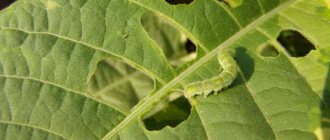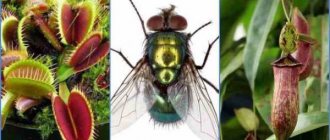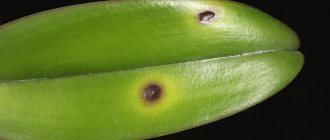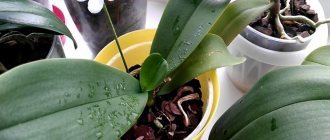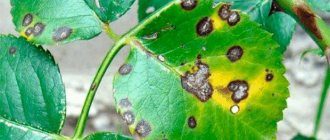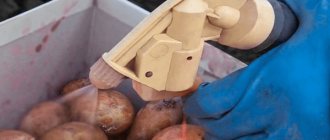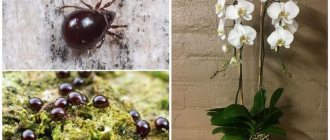If you carefully read our article about caring for Balsam, most likely your pet will not get sick. But it’s not always possible to take perfect care of your flower, because summer has come - it’s time for vacations. What should you do if you were away from home for a long time, and upon arrival you discovered that your Balsam was sick? Read the next article, in which we will talk about how to deal with diseases and pests of indoor Balsam.
Description and characteristics of the plant
Impatiens belong to the family of annuals, perennials and subshrubs of the same name, numbering about 500 representatives. In the wild, the plant is distributed in tropical and subtropical regions, Asia, and Africa. This flowering crop has entire leaves with shine, they are ovoid in shape and have jagged edges. Depending on the type, they can be of different shades - green, reddish, bronze.
The plant blooms with flowers of 5 petals, 4 of which are fused and directed downwards. Their diameter is from 2 to 4 cm. The petals of the flowers are either double or simple. They are painted in red, pink, yellow, white, and come in two colors. Flowering lasts from April to November. The flower has many popular names: for example, Vanka wet, Diligent Lizzy, Touchy, Ogonyok.
Why do the buds fall off?
Often, beginning flower growers are faced with situations when the “Vanka wet” flower begins to shed its buds. The main reasons for this phenomenon include violations of temperature and humidity conditions, excess nitrogen in the soil mixture and potassium deficiency. Another reason that can cause buds to fall off is a draft. Impatiens are very sensitive to drafts and cold snaps, which are stress factors for them. It is also necessary to check the condition of the soil mixture in the pot. It should not be over-moistened.
Despite the fact that this flower loves regular watering, excess moisture in the soil can cause its roots to die and the buds to fall off.
Common balsam diseases and their treatment
About 10 types of balsam are popular in home floriculture. They all love intense lighting, high humidity, well-moistened soil, and quality care. If you do not provide them with all of the above, then the flowers can be affected by many diseases. The fact that the causative agent of any disease has entered the plant’s body will be indicated by changes in appearance. If they are detected, it is necessary to establish what kind of disease has developed on the flower, eliminate the cause of its appearance and promptly treat it.
Did you know? People call balsam Impatiens due to the fact that even when you lightly touch the seed pods, seeds shoot out of them. And from Latin the name of the flower is translated as “sensitive”.
Root rot
This disease develops with excessive watering. It can be detected during transplantation, and suspected in the case of yellowing and falling leaves, observing a lethargic state. If the disease is detected in the early stages, the plant can be saved - it must be urgently transplanted into a new container and soil. After removing the flower from the ground, it is important to carefully examine the root system and remove roots damaged by the disease. The cut areas should be powdered with activated or charcoal. Healthy roots should be treated with any systemic fungicide for preventative purposes.
After transplanting, it is important to establish the correct regime and intensity of watering - it should be plentiful, but without flooding. If, after removing the bush from the ground, it turns out that most of the root system has been damaged by rot, then it is not advisable to save it. However, you can cut strong cuttings and grow young plants from them. The mother flower should be disposed of along with the soil and pot.
Gray rot
Symptoms of infection with this disease are brown spots on the leaves, white coating on the stem, and wilting. The most common cause of the disease is improper watering. For treatment, treatments with fungicides are used, for example, “Fitosporin-M” or others with a similar effect. To prevent disease, you need to water the flower correctly. The water should be settled and warm.
The next moistening is carried out after the top soil layer has dried. If bottom watering is used, it is important to drain the water remaining in the pan after 20–30 minutes. The plant should be planted only in a pot with holes to remove excess moisture, making sure to place a drainage layer of expanded clay, broken brick or other material on its bottom.
Important! When treating plants with chemicals at home, you should take personal safety precautions: protect your hands with gloves, your eyes with goggles, your nose and mouth with a mask. It is strictly forbidden to eat, drink, or smoke.
Powdery mildew
When growing in a room where it is constantly hot and dry, as well as with excessive moisture, there is a high risk of developing powdery mildew. A characteristic symptom of this disease is a white powdery coating on the leaves. It looks as if the foliage is sprinkled with flour. Initially, it appears on the lower leaves, which soon turn black and fall off.
When the first signs of the disease are detected, you should immediately remove the affected leaves and spray the flower with a fungicide, for example, “Skorom”, “Fundazol”, “Topaz”, or copper sulfate. After this, it is advisable to transplant into new soil and fertilize with potassium- and phosphorus-containing fertilizer.
Bacteriosis
Growing in cold temperatures and constant waterlogging can provoke the development of bacteriosis. A characteristic sign of the disease is black spots on the foliage. Unfortunately, this dangerous disease cannot be cured. It is important to detect it in time and destroy the plant before the disease spreads to other house flowers.
Bronzing
If a plant becomes infected with bronze, its leaves and stems wither and become deformed; small holes of different sizes and wrinkles are noticeable on the foliage. This disease, caused by a virus, cannot be treated - therefore, the plant will have to be destroyed.
Mosaic
The causative agent of this disease is a dangerous virus that is transmitted by parasites. Symptoms of balsam damage by mosaic:
- deformation of leaves;
- the formation of yellow spots on them;
- stem wilting;
- growth stop.
Like all viral diseases, mosaic cannot be cured, but in rare cases, indoor crops can be saved.
The flower must be isolated from other plants, the affected leaves must be cut off, treated against harmful insects, replanted in new soil and pot, and provided with high-quality care. Did you know? In indoor culture, balsam has been used since the 16th century. Medieval ladies decorated their rooms with it.
Biological effects
For every predator there is a worse predator. Thus, the enemy of the spider mite is the phytoseiulus bug. The artificial colonization of plants by these insects makes it possible to destroy the parasite with someone else's teeth, so to speak. Disadvantage: this method can only be used in closed ground conditions.
To combat ticks, biological products have been created: “Akarin”, “Bitoxibacillin”, “Fitoverm”. How to use them correctly?
- "Akarin" is diluted in a proportion of 2 ml of the drug per liter of water.
- “Bitoxibacillin” - 80-100 g per 10 liters of water. The disadvantage of this drug is that it can cause allergies upon contact with treated plants.
Both solutions are used throughout the growing season every 15-17 days.
“Fitoverm” is diluted in an amount of 10 ml per 10 liters of water. Processing is carried out every 7-10 or 14-20 days. The treatment period depends on the age and size of the plant.
The pesticides clofentesine and flufenzine belong to the hormonal group. They do not destroy all individuals at once, but sterilize the uterus. The effect of their use is long-term, but becomes noticeable after a few days. Some individuals die out, while others do not appear. If you need to destroy a tick urgently, you can mix this drug with any of the biological products.
Possible pests
Some harmful insects are also dangerous for balsam. Most often it is attacked by the following pests:
- Aphid. It is capable of completely destroying a flower in a short time by drinking the juices from it. It lives on the lower leaf plate and is a miniature green or black insect. The first signs of the presence of the parasite are yellowing and curling of the foliage. At first, you can help the plant by wiping it with soapy water. If such manipulations do not help, it is worth carrying out chemical treatments. Aphids are fought with the help of Fitoverm, Actellik, Intavir or other insecticides.
- Spider mite. In the course of its life, it entangles the flower with a web and feeds on the juices of the plant. Its appearance causes the balsam leaves to turn yellow, dry out and fall off, the flower withers and soon dies. To combat the pest, “Aktellik”, “Fitoverm”, “Sunmite”, “Aktofit”, “Fufanon” are used.
- Whitefly. This is a small butterfly with white wings. If you often see her fluttering near a flower, then she probably laid eggs on it, from which larvae will hatch and eat the leaves. They fight the butterfly and larvae by spraying with “Aktellik”, “Iskra”, “Aktara”, “Fitoverm”. Folk remedies are also used - treatment with tobacco, dandelion, garlic infusions, dusting with wood ash, washing with soapy water.
Why do the leaves curl?
There may be several reasons.
- Curling and deformation of leaves often indicate that the flower lacks moisture and light. These indoor plants do not tolerate lack of watering and darkness.
- Very dry air in the room can also cause leaves to curl. In this case, spraying allows you to restore their previous appearance.
- Direct sunlight can negatively affect the condition of leaves. To protect the plant from sunburn, it needs to be provided with soft but sufficient lighting. In hot and sunny weather, it is recommended to shade balsams.
Important! Having noticed that the plant is dying, and the shape of its leaves has changed greatly, it is important to carefully examine the flower for the presence of pests or traces of disease. It is best to inspect a problem plant using a magnifying glass.
Common growing problems and their solutions
In addition to the fact that balsam is sick and affected by parasitic insects, other problems may occur when growing it.
The leaves are curling
Curling of the leaves indicates that the plant has not been replanted for a long time, and it has become cramped in the pot. The situation can be corrected by replanting it in a new nutrient soil and a larger pot in diameter. Also, the leaves can curl if the flower lacks light. You need to move it to a brighter place or install additional artificial lighting. The same problem can occur due to the fact that the balsam is cold. The air temperature should be increased to the optimum - +20...+25°C.
Yellowing of leaves
The leaves of a plant that is under stress turn yellow. There can be several reasons for a stressful situation:
- sudden temperature change;
- reducing lighting intensity;
- exposure to drafts;
- long absence of transfers.
In summer, yellow spots on the leaves or their complete yellowing may indicate sunburn. To restore the flower to its former beauty, it is necessary to accurately determine and eliminate the cause. It is important to once again familiarize yourself with the recommendations for growing and caring for balsam, create favorable conditions for the flower and establish regular care for it.
Buds do not open
This state of the flower can occur if it was recently purchased or replanted: this sign may indicate adaptation. The flower's adaptation to new conditions usually lasts for a month. This condition does not require treatment - the balsam only needs to be properly cared for. After adaptation, the flower should grow and bloom on time.
The buds are falling
Buds fall off if the flower is grown in too cold conditions. It is important to remember that balsam is heat-loving, which means low temperatures are contraindicated for it. The lowest temperature this indoor crop can withstand is -13°C.
Also, the reasons that the plant drops buds are low humidity and insufficient watering. To fix the problem, you first need to monitor the temperature at which the flower grows, and then the humidity and pay attention to whether it receives enough moisture. If you bring each of the parameters to the recommended one, then most likely the buds will no longer fall off.
Stems stretch out
Stretching of stems and shoots occurs when there is a lack of light. You should move the pot with the plant to a brighter place and install an additional light source.
Important! In order for the crown of the bush to be uniform, the pot must be periodically rotated by 90°C: this way all sides of the plant will receive enough light.
Weak flowering
If the balsam does not bloom or produces too few flowers, and the flowering period is greatly reduced, then a possible reason may be planting in a container that is too large. In such a situation, the plant directs all its efforts to growing the root system and green mass and refuses to produce buds. The situation can be corrected by transplanting into a pot that matches the current size of the flower. After the root system has mastered the new earthen ball, flowering will begin. Lack of flowering is also observed when incorrect fertilizing is applied.
Fertilizing should be applied only during the growing season of the flower. Starting in October (if the flower does not bloom all year round), they need to be stopped and resumed in March. This break will allow the plant to rest and gain strength for flowering next year. Sluggish flowering also occurs if the flower is grown in the wrong conditions, namely at too high a temperature and low humidity. As soon as you adjust these parameters and bring them to the recommended ones, the plant will again delight with abundant color.
Preventive measures
The main aspect of prevention is proper care. It is advisable for a novice gardener to familiarize himself with the recommendations presented, which will make care easier and make him competent.
- Balsam requires moisture. The bush needs to be watered regularly and abundantly. To prevent waterlogging of the soil in the pot, you need to ensure good drainage. You can take pebbles, gravel, vermiculite and other components of your choice.
- When spraying, water should not linger on the green parts and flowers.
- It is better to fertilize in the fall. Fertilizers must contain phosphorus and nitrogen.
- The plant must receive enough sun.
- In winter, move the pot with balsam to a cool place (15-17 degrees), reduce the number of waterings.
- In the spring, young and old shoots that do not grow and do not produce flowers are pinched out (read about why balsam does not bloom, as well as tips on care and cultivation, here).
Impatiens is a popular houseplant with bright flowers and glossy greenery. It is characterized by increased moisture-loving properties. In such conditions, fungal diseases can develop. Improper care weakens the bush, and it becomes a target for pests. Mites, thrips, whiteflies, and aphids can parasitize balsam. They can be eliminated using acaricides (for ticks) and insecticides.
If you find an error, please select a piece of text and press Ctrl+Enter.
Recommendations for proper care at home
In this section, we have collected the most important recommendations that must be followed in order to achieve proper growth and development of the plant, its abundant and long flowering:
- The flower pot should be placed on the brightest windowsill. The best option is the western and eastern sides. When grown in the south, shading from direct sunlight will be required.
- In winter, to illuminate indoor crops, you need to install artificial lighting, preferably a fluorescent lamp.
- In summer, the flower will grow well in the fresh air.
- The best soil for growing balsam is a mixture of leaf soil, turf soil, peat and sand (in equal quantities).
- During the flowering period, the plant should be fertilized once every 14 days. Any ready-made composition designed specifically for flowering indoor crops is suitable for fertilizing.
- Watering is carried out with tap water, heated to room temperature, left for 1–2 days or passed through a filter.
- Regular spraying benefits the plant. If the room temperature is above +22°C, you need to spray it daily.
- To form a beautiful balsam crown, annual spring pruning is needed. All shoots are cut in half and the tops are pinched.
- Transplantation into a larger pot is carried out once a year, in the spring.
- It is not recommended to grow balsam for longer than 2-3 years. In the future, it will reduce its decorative effect and bloom worse. It is recommended to renew the plant by cuttings.
Thus, balsam is a beautiful indoor flower, which, in the absence of proper care and when grown in the wrong microclimate, begins to suffer from diseases. Most of them are treatable, but therapy should be carried out in a timely manner.
How to revive a flower?
For
In order to revive an already damaged flower, it is necessary to remove the infected areas. The plant itself must be treated with special preparations that help get rid of insects.
If you are afraid of recurrence, carry out the treatment again after 5-6 days. This will allow you to get rid of insects that, at different phases of their life cycle, may be immune to the components of such drugs.
If the problem is gray mold or root rot , then limit watering until the soil is completely dry.
Impatiens is a rather finicky, but beautiful indoor plant. It will be easy to grow if you follow all the requirements regarding watering, lighting and temperatures.
Reproduction methods
There are 2 main ways:
- cuttings;
- seeds.
To propagate by cuttings, you need to cut off branches 5 cm long, remove the lower leaves and place them in a container with water. After they take root, plant them in a pot with prepared soil. For better growth of the plant, you can cover it with a bag. After 2 weeks, remove the package. It is recommended to water abundantly.
To plant balsam seeds, you need to soak the seeds you collected yourself in a solution of potassium permanganate for a while. Planting is best done in early spring. Then place the seeds in boxes with soil, sprinkle with a small layer of soil. The box must be covered with a bag and watered constantly.
It is recommended to ventilate daily to prevent seed rotting. Shoots appear after 7 days, after which you need to remove the film. After 2-3 leaves form on the sprouts, they are transplanted into separate containers. After 5 months, flowering occurs.
Fighting spider mites with folk remedies
For an indoor green corner, a tick is no less dangerous an enemy than for a vegetable garden. Just as in garden beds, in flowerpots the parasite affects almost all species. The “almost” category includes Saintpaulia, Streptocarpus, Gersenia, and Uzumbara violets. In contrast, dracaenas, dieffenbachias, indoor roses, arrowroot, citrus fruits, and balsam are a favorite delicacy of the tick.
If this scourge has started in your apartment, disinfect the entire window sill and preventively treat healthy plants. In some cases, you may have to sacrifice one of the sickest flowers to save the rest. Ticks spread very quickly and hide well when unfavorable conditions occur.
Methods proven by folk experience have an effect no worse than industrial drugs. In any case, they will not cause harm to either humans or animals. The ingredients for the solutions are the simplest and most affordable. Not only indoor plants, but also those living in garden beds, especially cucumbers, can be treated with folk remedies.
At the first sign of disease, give the plant a cold shower every day. This is suitable for those species that do not mind such a procedure. You can use laundry soap or dishwashing detergent - wash the leaves, stems, pot, and window sill well. Chop approximately 150 g of peeled garlic in any way, add 1 liter of water and leave for 5-7 hours. Dilute the resulting concentrate in a ratio of 5 ml/1 l of water and use it to treat plants. Similar to garlic infusion, onion infusion is prepared, only it is used without dilution. Garlic cloves and onion pieces can be placed in a pot if the indoor plant does not like spraying. Cover the pot with a plastic bag. An infusion is prepared from the roots of dandelion: 20 g of roots per 1 liter of water. Take warm water. Can be used after a couple of hours. You can treat infected areas of hard-leaved plants with a swab dipped in medical alcohol.
This must be done carefully and quickly so as not to burn the leaves.
- Cyclamen. Boil several tubers of this plant for 40 minutes. After a day, the decoction is ready for use.
- Yarrow. Pour a bucket of boiling water over a kilogram of dried grass. After 3-4 days, add 3 tbsp to the strained infusion. spoons of grated laundry soap.
- Tar soap. Proportion: 10 g per liter of water.
- Turpentine. A jar of turpentine is placed near the affected houseplant and covered with a plastic bag for several hours.

